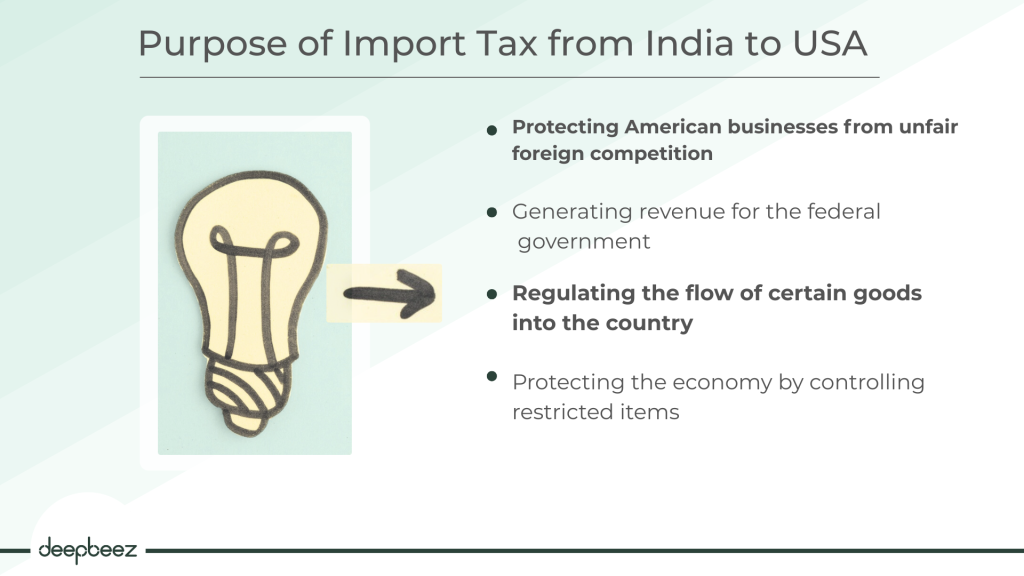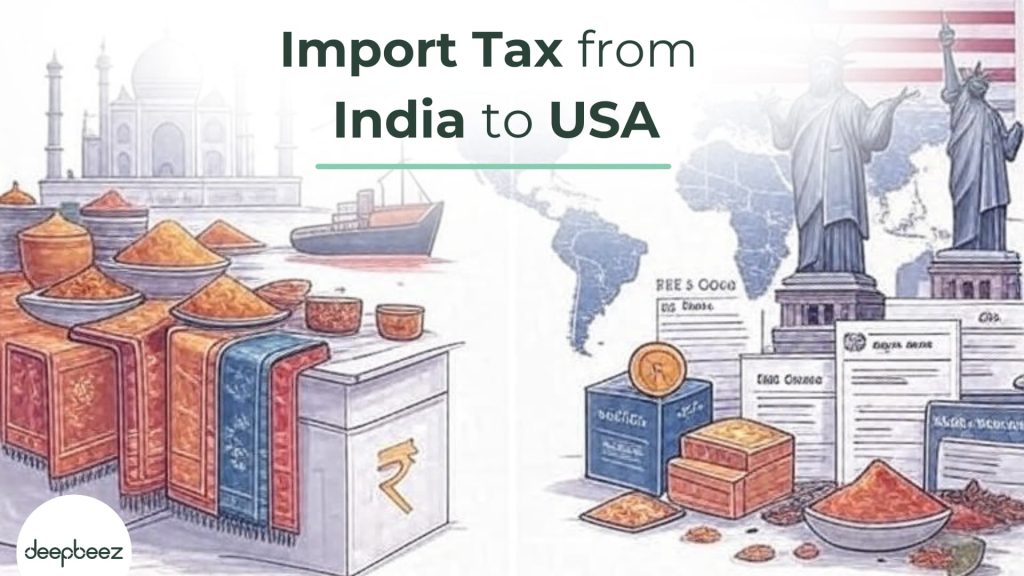Have you ever wondered why that package from overseas comes with unexpected fees? Or maybe you’re a business owner considering importing goods from India and want to understand the true cost of bringing products into the United States? You’re not alone – navigating US customs duty can feel overwhelming, but it doesn’t have to be. If you prefer to do all your task alone, you should learn how to calculate import and custom duty by HTS code.
What Exactly is Import Tax from India?
Think of US customs duty as a “entrance fee” for foreign goods coming into America. More formally, US Customs Duty is a tariff – essentially a tax – imposed by the United States government on goods brought into the country from foreign nations, including India.
But why does the government collect these fees? It’s not just about making money (though that’s part of it). These duties serve four main purposes:
- Protecting American businesses from unfair foreign competition
- Generating revenue for the federal government
- Regulating the flow of certain goods into the country
- Protecting the economy by controlling restricted items
Have you ever noticed how some foreign products cost significantly more than similar domestic ones? Customs duties play a major role in that price difference. Are you searching for a valid import tax from India to USA calculator? If you want to easily calculate your tax, Deepbeez Customs Duties Calculator will help you along the way.

How to Calculate Import Duties in USA from India
Ready to crunch some numbers? Let’s walk through a real example that shows exactly how import duty calculations work.
Imagine you’re importing 100 silk handbags from India to sell in your boutique. Don’t forget that you can also lower import duties by tariff engineering and duty drawbacks. Here’s how you’d calculate your duties:
| Calculation Step | Details | Amount |
| Product | Silk handbags from India | 100 units |
| HTS Code | 3926.90.33 | – |
| Standard Duty Rate | For handbags | 6.5% |
| Price per Unit | Cost from supplier | $25.00 |
| Base Calculation | 100 × $25.00 × 6.5% | $162.50 |
| New Liberation Day Tariff | Additional 27% on Indian imports | $675.00 |
| Total Duties | Standard + Additional tariff | $837.50 |
The formula is straightforward: Quantity × Unit Price × Duty Rate = Duty Amount
But remember, with the new 27% tariff on Indian goods, your calculation becomes: Standard Duties + (Total Value × 27%) = Total Import Duties
Think duties are your only cost? Think again! Several additional fees can impact your total import expenses:
| Fee Type | Rate | Minimum | Maximum | When It Applies |
| Merchandise Processing Fee (MPF) | 0.3464% of declared value | $27.23 | $528.33 | All imports |
| Harbour Maintenance Fee (HMF) | 0.125% of cargo value | – | – | Sea shipments only |
Cost Management Techniques for Import Duty in USA from India
- Accurate Classification: Double-check your HTS codes. A small classification error could cost you thousands in overpaid duties. Deepbeez HTS Code lookup will help you find the best and most accurate code.
- Negotiate with Suppliers: Consider asking your Indian suppliers to quote Delivery Duty Paid (DDP) terms, where they handle all costs until goods arrive at your location.
- Consider Duty Drawbacks: If you plan to re-export any imported goods, you could potentially recoup up to 99% of paid duties through the duty drawback program.
- Professional Help: Have you considered working with a customs broker? These professionals specialize in import compliance and can help you navigate complex regulations while potentially saving money through accurate classifications and documentation.
Key Factors That Determine Your Import Costs
When you’re importing goods, customs officials don’t just pick a random number for your duty. The calculation depends on several specific factors:
| Factor | Impact on Duty | Why It Matters |
| Product Type & Value | Determines base calculation | Different products have different duty rates |
| HTS Code Classification | Sets the exact duty rate | Misclassification can cost you money or cause delays |
| Country of Origin | Affects applicable rates | Trade relationships influence duty costs |
| Quantity | Influences total amount owed | Larger shipments mean higher total duties |
| Trade Agreements | Can reduce or eliminate duties | Unfortunately, no current US-India FTA exists |
Understanding the Harmonized Tariff Schedule (HTS)
Here’s where things get technical, but stay with us – this is important. The HTS code is like a product’s “postal code” in the import world. It’s a standardized numerical system that classifies every possible traded product.
Why should you care? Because getting this code wrong can be expensive. The HTS code directly determines your duty rate, so accuracy is crucial. Think of it this way: would you rather pay 6.5% duty on silk handbags or accidentally get charged a higher rate because of misclassification?
Additional Fees You Need to Know About
Beyond the basic customs duty, there are other charges that might surprise first-time importers. Let’s break down these additional costs:
| Fee Type | Rate | When It Applies | Calculation Method |
| Harbour Maintenance Fee (HMF) | 0.125% | Sea shipments only | 0.125% of cargo value |
| Merchandise Processing Fee (MPF) | 0.3464% | Most shipments | 0.3464% of declared value |
| MPF Minimum | $27.23 | When calculated fee is lower | Fixed minimum amount |
| MPF Maximum | $528.33 | When calculated fee is higher | Fixed maximum cap |
A Real-World Example of Import Tax from India to USA
Let’s say you’re importing $10,000 worth of goods by sea from India. Here’s what you might pay:
- Base duty: Varies by product (let’s say 5% = $500)
- HMF: 0.125% of $10,000 = $12.50
- MPF: 0.3464% of $10,000 = $34.64
- Total additional fees: $547.14
Does this help you see how these “small” percentages can add up?
Key Changes that Affect U.S. Import Tax from India
1- The De Minimis Rule Shake-Up
Here’s something many people don’t know: there used to be a “sweet spot” for small shipments. The de minimis threshold of $800 meant that packages valued at $800 or below were typically free from customs duties. Sounds great, right?
Well, recent executive orders have closed this loophole. Now, even items valued under $800 require formal customs entry and are subject to duties and tariffs. This change has increased both shipping times and costs for smaller shipments.
Are you someone who frequently orders items online from international sellers? This change might have already affected your shopping experience without you realizing it.
2- The New Liberation Day Tariff
Here’s a significant development that affects all India imports: Effective April 9, 2025, at 12:01 AM, all imports from India are subject to a 27% tariff. This New Liberation Day Tariff is non-negotiable and applies across the board, making importing from India considerably more expensive.
The only exception? Shipments that were already loaded and in transit before this date might avoid the tariff. If you’re planning to import from India, this 27% additional cost is a game-changer that you need to factor into your pricing.
How to Use Technology for Smoother Imports?
In today’s digital age, why make import calculations harder than they need to be? Modern digital logistics platforms offer features that can streamline your entire import process:
- Automated customs documentation
- Real-time duty calculations
- Deepbeez HTS Code Lookup assistance
- Integration with customs systems
These tools can significantly reduce errors and speed up the clearance process. Are you taking advantage of technology to optimize your import operations?
FAQ
- Do I have to pay customs duty on personal items shipped from India to USA?
Yes, you must pay customs duty on most personal items from India valued over $800. Even personal gifts are subject to duty unless they’re under $100 from most countries. The recent closure of the de minimis loophole means even small packages now require formal customs entry. - What’s this 27% Liberation Day Tariff I heard about on Reddit?
Starting April 9, 2025, at 12:01 AM, all imports from India receive a 27% tariff. This is non-negotiable and applies to all goods from India. Only shipments already loaded and in transit before this date can avoid it. - Can I avoid paying import duties by marking my package as “gift”?
No, this is illegal and considered customs fraud. Listing a lower value in order to avoid taxes is tax evasion and against the law. Customs can easily verify actual values through websites and other sources. - How much will I pay in customs duty for a $500 smartphone from India?
For a $500 smartphone, you’ll pay the base duty rate (varies by HTS code, typically 0-6%), plus the 27% Liberation Day Tariff, plus processing fees. Expect total costs of around $150-200 in duties and fees, making your phone cost $650-700 total. - What’s an HTS code and why does everyone on forums talk about it?
The HTS (Harmonized Tariff Schedule) code is a 10-digit number that determines your exact duty rate. The HTS is a reference manual that is the size of an unabridged dictionary. Getting it wrong can cost you money or cause delays. - My package got held at customs – what fees do I need to pay?
You’ll typically pay: base customs duty (varies by product), the 27% India tariff, Merchandise Processing Fee (0.3464% of value, minimum $27.23), and possibly Harbor Maintenance Fee (0.125% for sea shipments). Expect $50-200+ in fees depending on value. - Is the $800 duty-free threshold still valid in 2025?
Recent executive orders have closed this ‘de minimis’ loophole, now requiring formal customs entry and subjecting items under $800 to duties and tariffs. The $800 rule no longer applies. - Can I import Indian supplements/vitamins without paying duty?
No, supplements and vitamins from India are subject to customs duty. Based on Quora experiences, when I ordered first time… it will definitely go through customs. Even personal use items aren’t exempt. - My supplier gave me an HS code – can I use that for USA imports?
No, your supplier’s HS code is only 6 digits. It is important to note that as an importer in the US you need to use HTS codes and not HS codes. You need the full 10-digit HTS code for USA imports. - How do I calculate the total cost of importing textiles from India?
Add: product cost + shipping + insurance + base duty rate (varies by textile type, typically 10-25%) + 27% Liberation Day Tariff + 0.3464% processing fee + 0.125% harbor fee (if by sea). A $1000 textile shipment could cost $1400-1500 total. - Can I ship used personal items from India to USA duty-free?
Used household items can be imported duty-free when relocating to the U.S., provided they have been in possession and used for at least one year. This only applies when permanently relocating, not for regular shipments. - What happens if I use the wrong HTS code?
Using wrong HTS codes can result in overpaying duties, underpaying (leading to penalties), or package seizure. If you do intentionally use the wrong code, you may face penalties, seizure of your import or harsher consequences. - Do I pay duty on the shipping cost too?
United States calculates using the FOB method, which means the import duty and taxes are calculated only on the customs values of the imported goods. Shipping costs aren’t included in duty calculation, unlike in India. - Can I split one large shipment into smaller ones to reduce duties?
Multiple shipments from the same sender to the same recipient on the same day may be treated as a single shipment, potentially exceeding this threshold. Customs may combine related shipments, and deliberately splitting to avoid duties is illegal. - My friend says books don’t have import duty – is this true?
There are no taxes on importing books in many cases, but they’re still subject to the 27% Liberation Day Tariff from India. So books aren’t completely duty-free anymore. - How long does customs clearance take for packages from India?
Normal clearance takes 1-3 business days, but incorrect documentation, wrong HTS codes, or random inspections can extend this to 1-2 weeks. The 27% tariff adds processing time as it’s relatively new. - Should I use a customs broker for my small business imports?
It’s a good idea to use a licensed customs broker to file paperwork and verify the HTS code. Sometimes importers with lack of experience tend to misuse the HTS code. For regular importing, broker fees often pay for themselves. - Can customs assess my package at a higher value than I paid?
Yes, The customs officer in India may however assess the product’s value as, say, $600 and in that case, you will have to pay the 18% customs duty on $600 (the assessed value) and not $500 (the invoice value). This applies to USA customs too. - What’s the cheapest way to import electronics from India after the new tariff?
Unfortunately, there’s no legal way to avoid the 27% Liberation Day Tariff. Your options are: negotiate better prices with Indian suppliers, consider alternative countries, or factor the 27% into your business model. The tariff applies regardless of shipping method or value.





